Your Ultimate Guide To Balsamic Vinegar
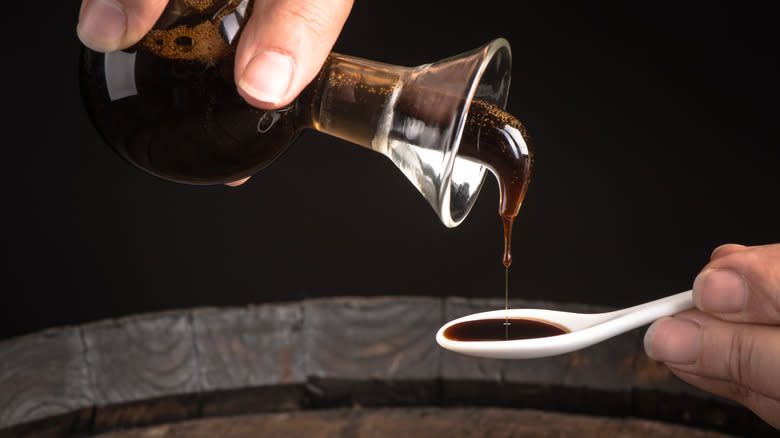
There's nothing like a splash of vinegar to round off a dish before serving, yet this tangy ingredient has so many nuances that deserve a closer look. From basic household white vinegar to traditional balsamic vinegar of Modena, the range in flavor, quality, and cost is vast. While you might think the bottle of balsamic you're picking up at the grocery store is the real deal, it turns out the finest stuff isn't so easy to come by. With local production in Modena topping out just over 2,000 gallons a year, most people aren't consuming the traditional product.
As a fan of balsamic vinegar (to the extent that I knew it), I went to the source in Modena, located in Italy's Emilia Romagna region. Here, I visited Acetaia di Giorgio, a family-run balsamic vinegar producer from the late 1800s. As I learned about the multi-step process of making the richly flavored vinegar, I immediately realized I had never actually tasted it before. That was soon rectified, as the visit included a tasting of vinegars aged in assorted types of wood. Here's the rundown on everything balsamic vinegar.
Read more: Vinegar Cooking Hacks You'll Wish You Knew Sooner
What Is Balsamic Vinegar?
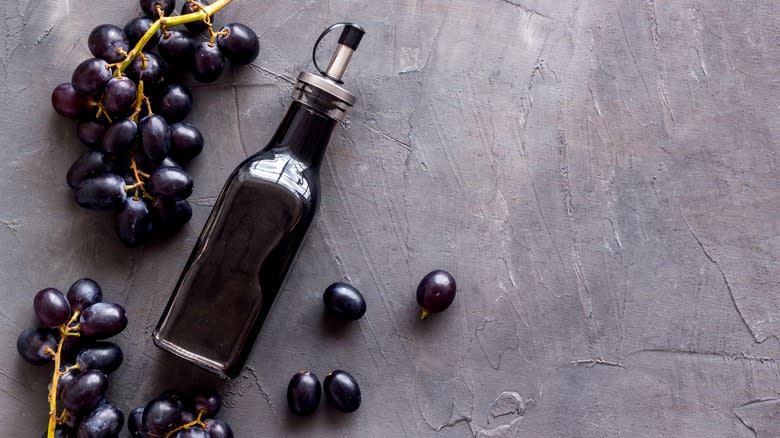
You might add balsamic vinegar to dressings and drizzle the glaze over a Caprese salad, but you've probably never stopped to think about it beyond its role as a condiment. The vinegar is made with grape must that becomes acidic over a lengthy period of time, developing various flavors based on its aging regimen. Whereas traditional balsamic vinegar of Modena is only allowed to contain local red and white grapes, more industrialized processes begin with wine vinegar and include additives like sugar, caramel, and chemicals to modify the color and taste.
Whether you're picking up a basic bottle from the grocery store or splurging on a finer one directly from an acetaia (a vinegar producer), the condiment is primarily used as a culinary ingredient nowadays. If you're going all out on the real deal, a subtle amount as a finishing touch on food is all you need. That being said, most people are likely to pick up a standard bottle of the industrial stuff, which still works well as a component of a vinaigrette or marinade.
What Are The Origins Of Balsamic Vinegar?
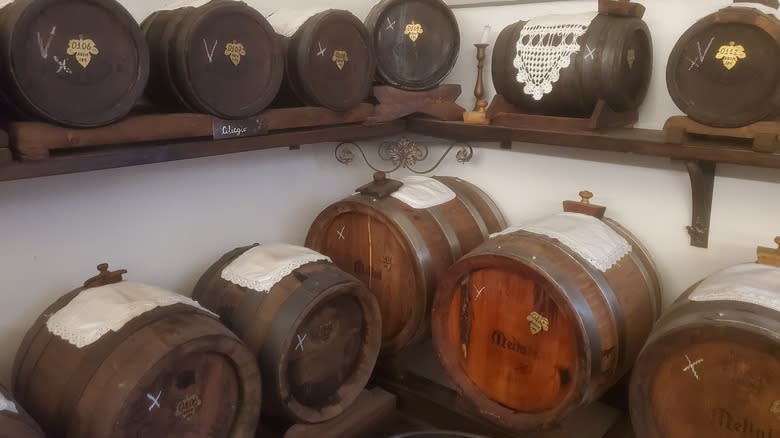
Balsamic vinegar production likely traces back several hundred years to the 11th century, when it was originally made by families in the provinces of Modena and Reggio Emilia in Italy's Emilia Romagna region. In areas also popular for wine production, it's natural that grape vinegar soon followed.
As Marcello Castelli from Acetaia di Giorgio explains, "In origin, this vinegar was a medicine for the stomach, for digestion. [...] Balsamico from the Greek balsamo means natural medicine, natural remedy." Nowadays we use it to add flavor to a dish, but some people still swear by a teaspoon to aid with digestion following a meal.
In the past, barrels containing the grape-based vinegar were even gifted as wedding dowries, as Castelli notes. While its use has since expanded, at its essence traditional balsamic was a prized product used as a commodity between families, a tradition that dates back centuries. With its popularity came more restrictions to guarantee its quality, consistency, and above all, authenticity.
How Is Traditional Balsamic Vinegar Made?
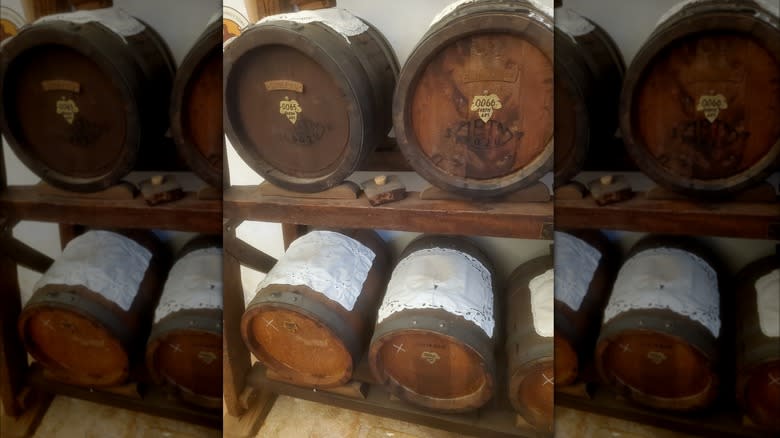
Traditional balsamic vinegar production is all about time and patience. Whereas industrial production can take place over a short period of time, the traditional product from Modena requires a minimum of 12 years of aging in barrels. It starts with cooked grape must, and the liquid is added to a series of wooden barrels of decreasing size as it ages. A set requires at least three barrels, which are all left open and covered with a doily to protect the vinegar from any particulate. The action of acetobacter slowly begins to occur in the barrels, imparting the characteristics of vinegar to the juice.
Castelli explains, "During the aging process [the vinegar] needs first of all a high concentration," which he notes occurs naturally due to evaporation. As the water in the juice evaporates, the volume reduces so the barrels must be refilled once a year. Per Castelli, "Starting from the first one, the smallest, we refill vinegar from the second. For the second only from the third, from the third only from the fourth. [...] At the end, we refill the biggest barrel with fresh grape juice that we prepare year after year."
In traditional production, the vinegar continues to age, developing flavors from the wood, increasing in concentration and sweetness, all while decreasing in acidity. The base aging is 12 years, but the top-tier balsamic vinegar of Modena requires 25 years of aging.
What Regulations Does Traditional Balsamic Vinegar Production Follow?
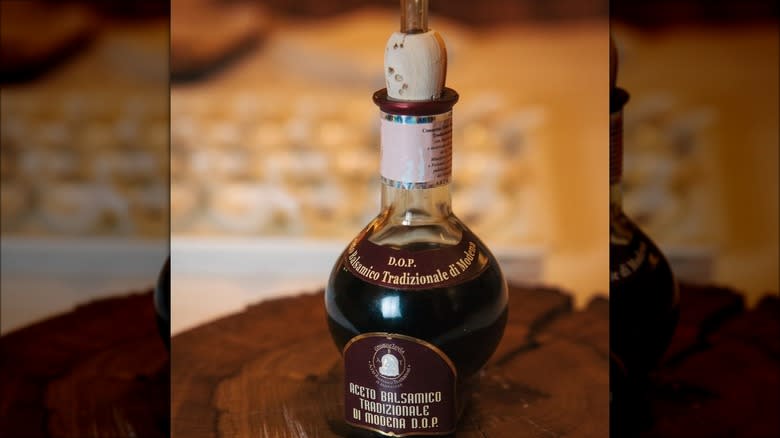
Obtaining a Protected Designation of Origin (PDO) certification does not occur without well-directed efforts. Traditional balsamic vinegar of Modena is regulated by a consortium that has overseen production for close to 50 years. Aside from spreading the product's reach worldwide, the organization ensures that it retains the qualities that make it unique, in order to guarantee authenticity to consumers. Only around 100 producers continue to make traditional balsamic vinegar of Modena, further adding to its value.
The product must be made from start to finish in Modena or Reggio-Emilia, using only local grape varieties. After the maturation process in wood that lasts between 12 to 25 years, the organoleptic properties must then be assessed by the consortium.
"When they receive the vinegar, [...] they make a commission panel of five master tasters, like sommeliers for wine," Castelli explains. In the process, "the panel has to observe, smell, and taste the vinegar," which ultimately garners a score. If it is sufficiently high, the consortium will bottle the product, which can only be done in specific 100-milliliter bottles stamped with the PDO certification and seal.
Traditional Balsamic Vinegar Vs Industrial Balsamic Vinegar
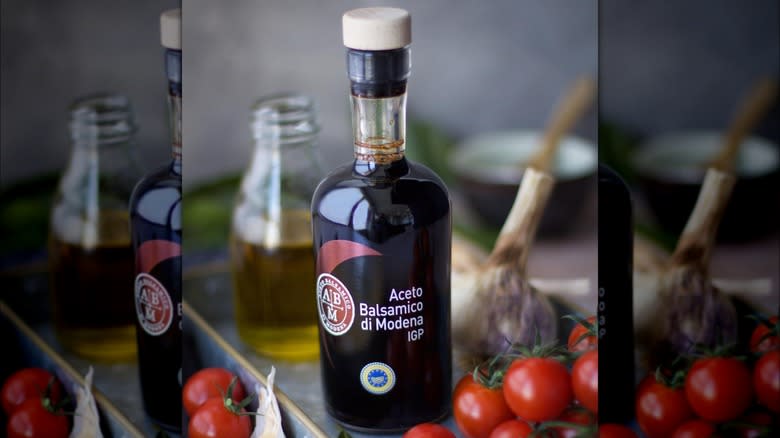
Although they're both called balsamic vinegar, the distinctions between the traditional PDO product from Modena and industrial ones commonly certified as PGI (protected geographical indication) are vast. PDO products in Europe (such as Parmigiano-Reggiano cheese and Champagne) face far more regulation regarding production, whereas PGI guidelines are looser and allow for more leeway.
When it comes to balsamic vinegar, the PGI product is produced from grape must from specific varieties with the addition of wine vinegar and a small percentage of caramel for color. Other products with fewer regulations may contain added sugar and compounds to balance out the flavor, color, and acidity.
On the flip side, PDO balsamic vinegar is only permitted to contain grape juice from local vines. The final color and taste are all byproducts of the lengthy aging process in wooden barrels. Industrial PGI vinegar undergoes a minimum of 60 days in wood, which might round out the taste but does nothing compared with a dozen years or more. Some products are aged beyond three years for more complexity but are still far from traditional vinegar.
Which level of vinegar you're faced with will become obvious when you look at the price tag (PDO is higher) and the format of the bottle. PDO can only be sold in 100-milliliter glass bottles produced by Italian designer Giugiaro, whereas PGI vinegar comes in 250-milliliter containers and larger.
What Does Balsamic Vinegar Taste Like?
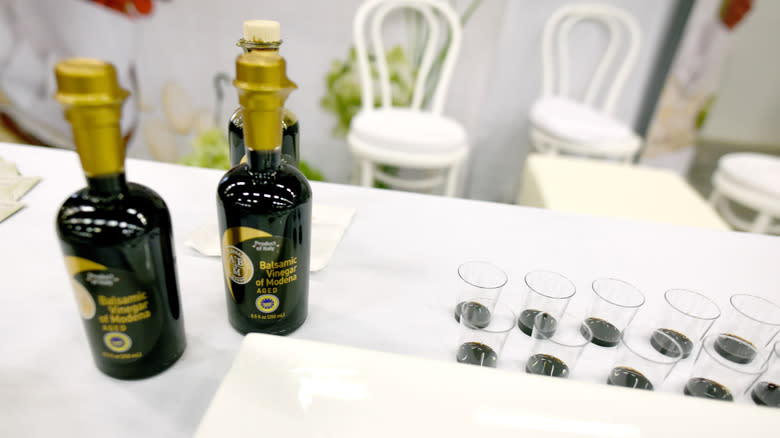
Depending on whether you're splurging on a pricey bottle of traditional balsamic vinegar of Modena or sticking to more affordable versions at your closest grocery store, you'll be faced with a range of flavor profiles. That being said, in general, balsamic tends to have a delicate balance of sweet and sour flavors compared with other types of vinegar. PGI balsamic requires a minimum of 6% acidity content, which gives it a distinct tang that complements olive oil and other fatty ingredients. It also has a subtle woodsy flavor thanks to some time spent aging in wooden barrels.
Meanwhile, traditional PDO balsamic vinegar of Modena faces a far lengthier aging regimen in wood, which infuses it with more complex flavors derived from the vessels. These will vary depending on whether the vinegar is aged in a series of different types of wood or solely in one variety. For example, Castelli comments, "Juniper is more peppery, cherry is very sweet," and notes, "those two are most distinct." The intensity of the former makes it a great pairing with meat and grilled foods, whereas the latter works well with desserts. Younger vinegars aged for the minimum 12 years tend to be bolder and more acidic than those aged 25 years or more.
How To Use Balsamic Vinegar In The Kitchen?
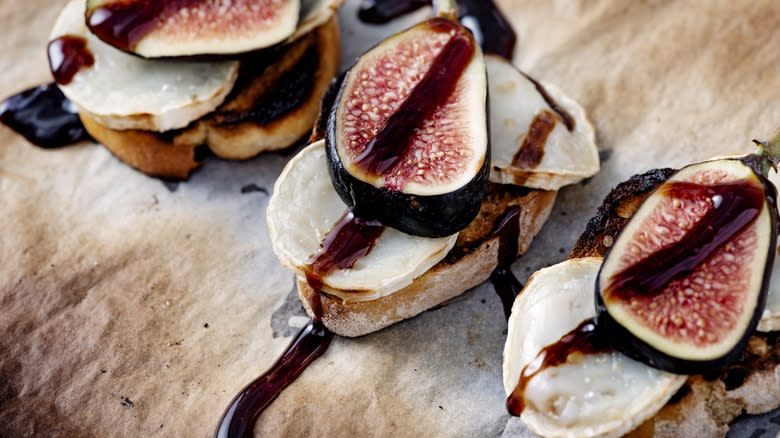
Balsamic vinegar has a bold flavor that makes it a delicious condiment to add a sweet and tangy boost to a range of dishes. As Castelli describes, "We only have to drizzle on top a few drops of vinegar only at the end of the cooking," further explaining, "so we never have to cook with or marinate with the vinegar, it goes as a final touch at the end." Whereas some types of vinegar work best as a component of a sauce or dressing, traditional balsamic vinegar of Modena shines best as a stand-alone condiment, making it very easy to include in your culinary repertoire.
Castelli has several recommendations for pairings with the acetaia's range of vinegars aged in different types of wood. Balsamic vinegar of Modena can accompany pretty much anything — even gelato (vanilla and cream flavors are his favorite matches). It goes well with salads, soft and hard cheeses, fish, grilled meat, beef tartare, carpaccio, grilled vegetables and fruits, risotto, and pasta ... it really is a versatile ingredient. Meanwhile, industrial balsamic vinegar tends to be more acidic and less viscous, making it more suitable for olive oil-based dressings.
Varieties Of Balsamic Vinegar
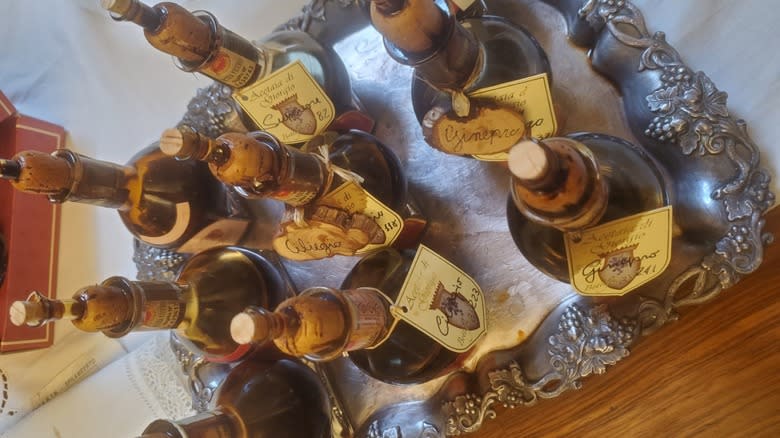
Aside from the vast distinction between the traditional and industrial products, balsamic vinegar has other nuances as well. However, Castelli notes that color isn't one of them when it comes to the PDO product. "Because of the oxidation it's impossible to produce white balsamic vinegar," he states, noting that whatever you find labeled as such has been altered chemically to modify the color. "Even starting with only white grapes, trebbiano grapes, the final color will always be dark brown. So again, white balsamico is not balsamic vinegar, it's only marketing," he emphasizes.
More importantly, the type of wood used for aging imparts different characteristics to the final product. The local varieties permitted for aging traditional balsamic vinegar of Modena include cherry, juniper, ash, mulberry, oak, and chestnut. "It's up to the producer to age the vinegar in a series of barrels with multiple types of wood," Castelli explains, which can mean in all six or a reserve product highlighting a single kind of wood.
Much like different types of wood have distinct aromas and profiles, they impart unique flavors to the resulting vinegar during the aging process. To avoid overpowering the natural aromas of the vinegar, barrels are seasoned for a few years with hot water and vinegar in order to tame the taste of the wood. Still, the wood will continue to infuse flavor notes into the vinegar for decades; in fact, Castelli asserts that barrels get better with time.
Where To Buy Balsamic Vinegar
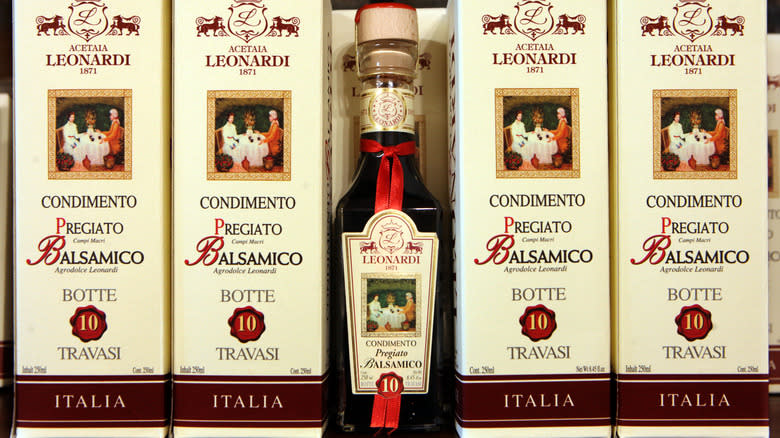
If you aren't too fussy about the type of balsamic vinegar you're purchasing and don't want to spend more than a few dollars, you're in the market for an industrial product you can easily pick up from the grocery store. If you want something a little more refined, keep an eye out for the PGI certification label on the bottle, which regulates several steps of the process to ensure quality vinegar.
There are very few merchants who sell traditional PDO vinegar in the U.S., and authenticity can be questionable. If your love for balsamic vinegar extends beyond rational everyday purchases, you might consider going to the source and visiting a traditional acetaia in Modena or Reggio-Emilia in Italy. A simpler alternative would be to buy your vinegar directly from an acetaia's website or from the balsamic vinegar consortium and have it shipped. As the traditional bottles must be 100 milliliters, the shipping costs shouldn't be too prohibitive.
Nutritional Information About Balsamic Vinegar
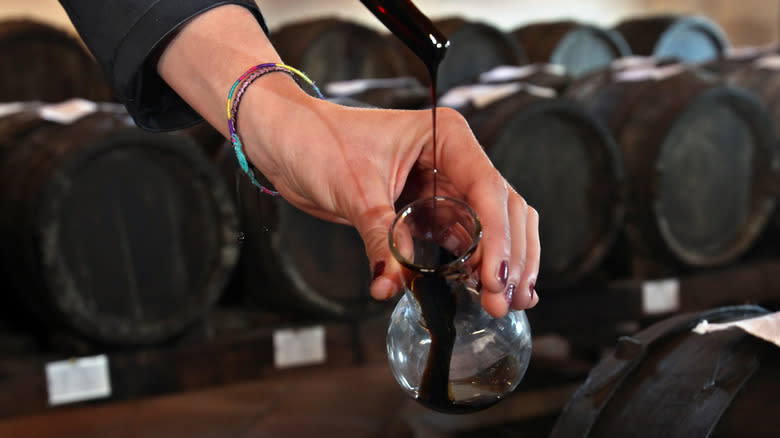
Given that it was once more common to use traditional balsamic vinegar as a health aid than for culinary purposes, it's fair to say that it sits on the healthier end of the spectrum. The PDO product offers more benefits than PGI or industrial vinegar which contains additives since it is only made with grapes. PDO vinegar's, nutritional makeup consists of carbohydrates and fructose, with no fat and minute quantities of protein. Packed with flavor, it makes an excellent low-calorie condiment to dress up a dish.
As per its original use, balsamic vinegar can aid in digestion, thanks to the healthy bacteria content contained in acetic acid (via Healthline). Other possible health properties attributed to the vinegar include decreasing LDL cholesterol, improving circulation, and even assisting in weight loss. Granted, your vinegar consumption would need to be pretty regular to obtain these benefits — without overdoing it, of course, to avoid heartburn.
How To Store Balsamic Vinegar
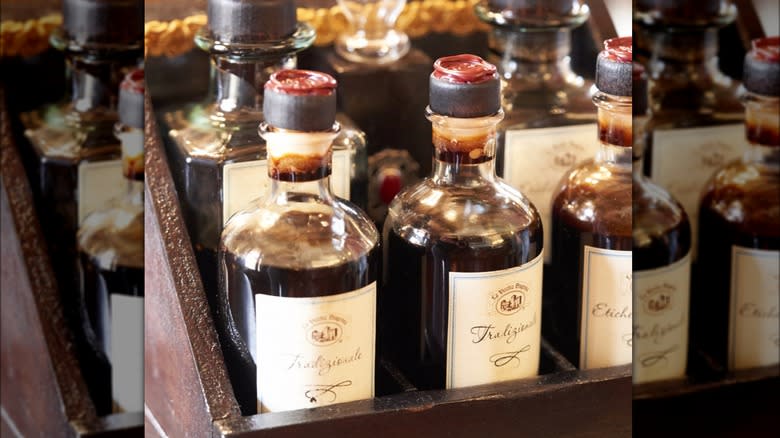
Standard PGI or industrially produced balsamic vinegar fares well in most conditions. You'll find it on the shelves of grocery store aisles and it doesn't require any specific storage. Although the process of making traditional PDO balsamic is far more involved, it too can be kept at room temperature with no worry. Avoid refrigerating the finer stuff or it will quickly become too thick to drizzle over foods, compromising its delightfully syrupy consistency.
Castelli also points out that even though the bottles are labeled with expiration dates 10 years from bottling, this is just a general food law in Italy. That being said he notes, "We could keep this bottle, even open, 12, 15, 20 years, and basically the vinegar would always be the same. Because the vinegar has [been for] 25 years or more in open barrels, we wouldn't have problems once in bottles." To keep it optimally fresh and limit further evaporation, just keep it at room temperature with the top closed.
How Is It Different From Other Types Of Vinegar?
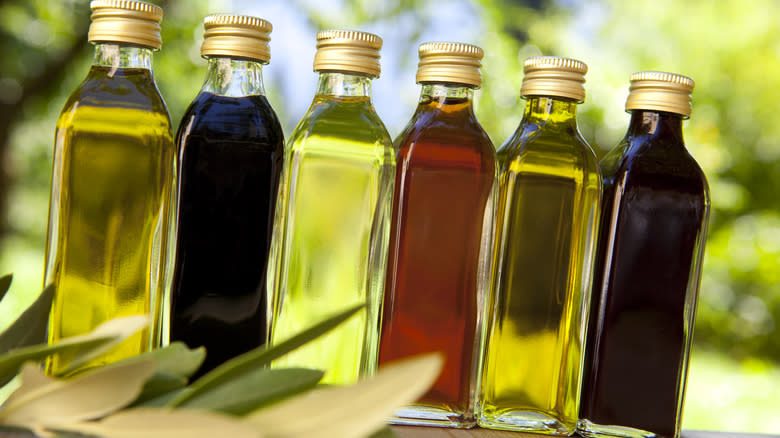
There are many types of vinegar on the market, such as distilled white, red or white wine, apple cider, malt, rice, and plenty of artisanal varieties. Each one is made with specific ingredients and processes that differ slightly, though the result is always the development of acetic acid. Distilled white vinegar consists of grain alcohol and water, making it strong, acidic, and equally worthy in a recipe or as a cleaning supply.
Wine vinegars begin with wine, making them subtler than distilled white. Wine vinegars are the precursors of industrialized balsamic vinegars, which makes them the most similar. Other vinegars like apple cider and rice begin with those base ingredients, which infuse fruity and sweet flavors into the final product. Balsamic vinegar is different from other vinegars because it is made from grapes, and more so due to its aging regimen in wood.
Why Is It So Expensive?
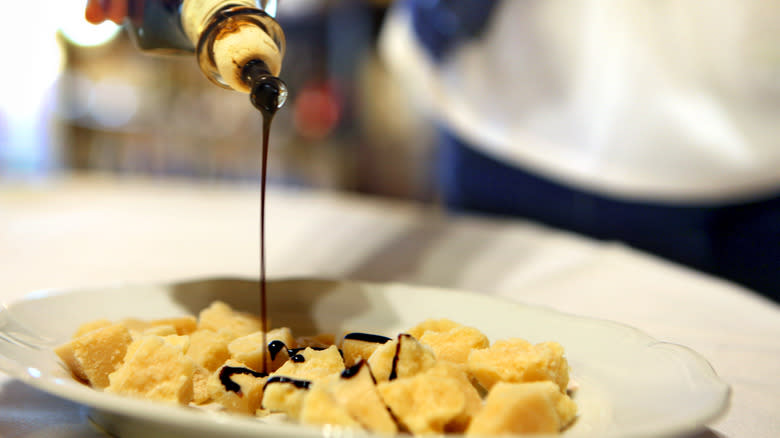
Considering there are so few producers still making traditional balsamic vinegar of Modena, it is undoubtedly rare. Add to that the fact that a balsamic producer will only be able to start selling vinegar after a minimum of 12 years (without taking into account the time to season the wood barrels if they were to start from scratch), it's not surprising that the final product has an elevated price tag.
Not only does it require a lengthy period of time before it can actually be sold, but it also decreases in volume over time. Although the evaporation produces the prized flavors of the vinegar, it also means that the quantity drastically reduces from the amount of grape juice originally introduced into the vessel. So much so that Castelli estimates, "we lose about 20% of the product every year into each barrel."
Producers must receive the go-ahead from the consortium before requesting the vinegar be bottled, further adding to the overall price. With this level of care, attention, and patience, it's not so wild to think that 12-year-old traditional balsamic vinegar of Modena sells for a starting price of around €50 (or $55).
Read the original article on Tasting Table.